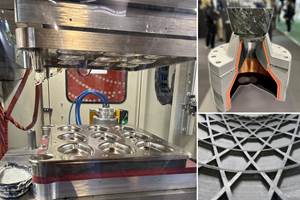Cevotec joins Airbus-led R&D on CFRTP fuselage frames
Cevotec contributes its FPP preforming expertise to the 3‑year feasibility and maturation project driven to reduce weight, increase layup rates and develop a scrap‑lean process chain.
Figure 1. Illustration of off-axis ply placement using fiber patch placement (FPP) technology. Source (All Images) | Cevotec
Cevotec (Munich, Germany) is participating in an Airbus (Toulouse, France)-led R&D consortium within the German aerospace research program “LuFo VII-1,” that is focused on developing a high-rate manufacturing route for carbon fiber-reinforced thermoplastic (CFRTP) fuselage structures.
The 3‑year program, launched in August 2025, centers on technology route development and validation. The consortium comprises Airbus (Lead), the German Aerospace Center (DLR), Fraunhofer institutes IGCV, ICT and IFAM, the Leibnitz Institute IVW and Cevotec. Cevotec is contributing its fiber patch placement (FPP) preform expertise for off‑axis (±45°/90°) ply layup for fuselage frames (Fig 1.), providing a technology module for a future integrated process chain that also includes automated 0° ply layup, stamp forming and trimming. The shared goal? To reduce weight, increase layup rates and develop a scrap‑lean process chain that can support future production of more than 75 single-aisle aircraft per month.
The project team intends to build up the modules of a future integrated process chain, purpose‑built for rate and repeatability. Cevotec’s robots place off‑axis patches (±45°/90°) to form complete stacks. Zero-degree plies that carry axial loads efficiently will be placed by Fraunhofer IGCV using thermoplastic composite (TPC) automated fiber placement (AFP). Airbus then takes over with stamp forming; the preforms are heated and shaped in seconds, followed by trimming and downstream finishing.
The process will be digitally defined and traceable; placement data can be used to verify that fiber orientations and locations match design intent. An AI-driven vision system to monitor the accuracy of placement will be investigated. Those will be building blocks of a “first‑time‑right” process that minimizes scrap and stabilizes quality across shifts and manufacturing sites.
The project is guided by an ambitious set of outcomes, says Cevotec. First, weight: Moving to CFRP frames is a direct lever on reducing airframe mass, resulting in lower fuel burn and emissions over the aircraft’s life. Second, rate: Each step — from placement to forming — must fit a takt‑time‑driven environment capable of supporting more than 75 aircraft per month. Third, cost and sustainability: By combining precise patch placement with robust forming, partners are targeting a step‑change reduction in production scrap and a path to circularity enabled by thermoplastics.

Figure 2. Virtual manufacturing cell Cevotec Samba Step L system (digital mock-up for frame preforming).
For the intended process chain, FPP is expected to achieve higher layup rate than AFP for off‑axis plies on complex geometries. AFP remains the efficient choice for the curved, continuous 0° layers, while FPP is applied to lay up the non-zero (i.e., “off-axis”) plies. In one fast placement operation, a wide patch with the desired fiber orientation can be placed. Compared to multiple AFP placement operations required to cover the same width, FPP offer the opportunity to improve cycle and takt time, thereby process economics and rate capability.
The shared goal? To reduce weight, increase layup rates and develop a scrap‑lean process chain that can support future production of more than 75 single-aisle aircraft per month.
The HERA project focuses on validating technology modules for a high-rate thermoplastic process chain for future aircraft structures. To develop and validate the FPP module, Cevotec will modify and expand the capabilities of its Samba Step L lab system (Fig. 2). This equipment offers a high flexibility to integrate project-developed sub-modules, while benefiting from general precision placement of larger plies as validated in previous aerospace projects.
This research program is supported by the Federal Ministry for Economic Affairs and Energy (BMWE) under the support code 20W2405E.
Related Content
Development of a composite liquid hydrogen tank for commercial aircraft
Netherlands consortium advances cryogenic composites testing, tank designs and manufacturing including AFP, hybrid winding, welding of tank components and integrated SHM and H2 sensors for demonstrators in 2025.
Read MorePlant tour: Collins Aerospace, Riverside, Calif., U.S. and Almere, Netherlands
Composite Tier 1’s long history, acquisition of stamped parts pioneer Dutch Thermoplastic Components, advances roadmap for growth in thermoplastic composite parts.
Read MoreUpdate: THOR project for industrialized, recyclable thermoplastic composite tanks for hydrogen storage
A look into the tape/liner materials, LATW/recycling processes, design software and new equipment toward commercialization of Type 4.5 tanks.
Read MoreJEC World 2024 highlights: Thermoplastic composites, CMC and novel processes
CW senior technical editor Ginger Gardiner discusses some of the developments and demonstrators shown at the industry’s largest composites exhibition and conference.
Read MoreRead Next
Assembling the Multifunctional Fuselage Demonstrator: The final welds
Building the all-thermoplastic composite fuselage demonstrator comes to an end with continuous ultrasonic welding of the RH longitudinal fuselage joint and resistance welding for coupling of the fuselage frames across the upper and lower halves.
Read MoreCevotec Samba Pro PV commissioned at NCC in Japan
Synergies between Cevotec, Fuji Industries, the NCC Japan, Fraunhofer IGCV and the ICC contributes to advancing knowledge exchange, FPP H2 tank development in Japanese manufacturing.
Read MoreScaling up, optimizing the flax fiber composite camper
Greenlander’s Sherpa RV cab, which is largely constructed from flax fiber/bio-epoxy sandwich panels, nears commercial production readiness and next-generation scale-up.
Read More












